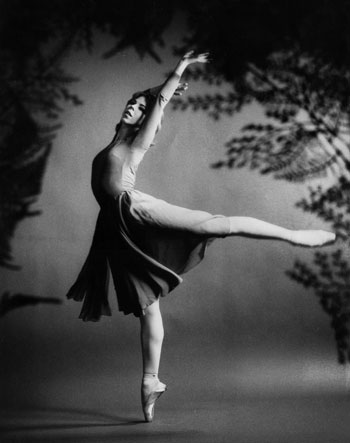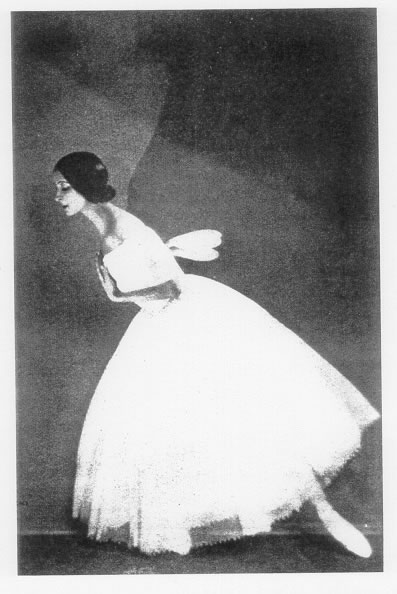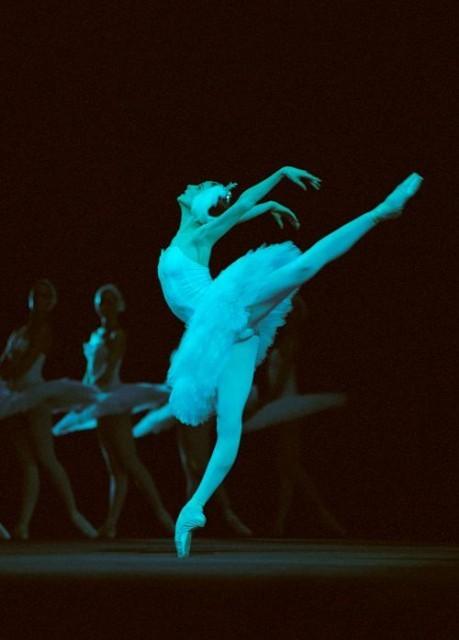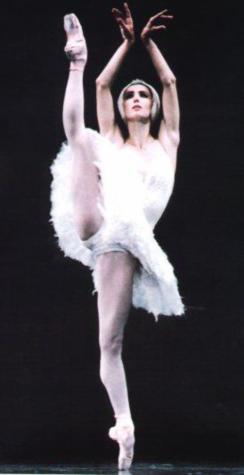The evolution(?) of extreme ballet
This article documents a trend I’ve noticed for decades: ballet lines have become more exaggerated over time. This is especially true of what is known as “extrension”—that is, the height of the nonsupporting leg when it is raised. But it’s also true of the curve of the foot itself, the flexibility of the back, and the general shape made in space:
Daprati [a researcher based at the University of Rome] raided the archives of London’s Royal Opera House for photos and videos of dancers from 1946-2004…She reduced each image to a stick figure and calculated the angle between the raised “working leg” and the vertical supporting one. For each position, Daprati found that this angle increased as the years went by. Take developpe a la seconde – in the 1940s, dancers held their moving leg just above the 90 degree level, but today’s dancers effectively extend it straight up with an incredible 180 degree gap between their two legs.
This sort of thing results in a very different type of ballet dancer than the ones I saw as a child.
Although many arts contain elements of the physical—for example, musicians must use their bodies to coax a glorious sound from inanimate instruments—dance has always been the art that most seamlessly merges the athletic with the esthetic as well as the dramatic. But balance must be there or it becomes an empty physical exercise (what some of my dance teachers used to call circus tricks or nightclub acts), sensational in the physical sense, empty of the soul that makes it all meaningful.
One of the things I liked so much about a Russian dancer from my youth, Maya Plisetskaya (about whom I’ve written previously, here), was that her unique physical attributes—a powerful jump, pliant back, and sinuously flexible arms—were combined with extraordinary musicality and a rare emotional fire. It is unusual for these elements to be displayed in the same dancer; for example, strength and flexibility are natural antagonists in the human body, and dancers most often favor one over the other. The triple package—power, suppleness, and drama—is exceptionally rare.
But let’s start with the physical. As the raised legs get higher and still higher, the line of the body changes dramatically. Ballet was originally designed to feature more gentle poses involving curves, but lately those arcs have become more excessive, and other elements have become sharper and more angular. In ballet’s quest to achieve ever more sensational physical effects to make the audience gasp, the artist has all too often been sacrificed to the athlete, even in the most famous of dancers.
Take a look at a few examples of the pose known as “arabesque,” then and now. This first photo is of Sallie Wilson, who danced with American Ballet Theater during the 60s and 70s. She was a physically strong but not especially flexible dancer known for her intensely dramatic interpretations of Tudor classics.
Note the gorgeous sweeping curved arc Wilson’s modestly elevated back leg makes with her elegantly upraised torso, a line that is fully extended through the position of her arms and head. I saw this photo decades ago, when it was first taken, and remembered it all these years as a thing of rare beauty:
We have no photographs of one of ballet’s originators, Marie Taglioni, who in the 1830s perfected the art of dancing en pointe and making it look easy. But we do have this lithograph:
It conveys the essence of Taglioni’s art: to appear otherworldly and gossamer, a creature of clouds and air, perched on toe as a butterly hovers rather than balancing there like a circus performer. Her other leg is held quite low; no need to fling it skywards to create the effect she’s after.
But that’s just a drawing, you say; she didn’t really look like that. Well, here’s Anna Pavlova; no doubt you’ve heard of her. She popularized ballet by touring the world during the early part of the 20th century. She was a petite woman with a tiny foot:
Her leg is a bit higher than Taglioni’s, but it’s the same idea: delicate and weightless, she alights rather than poses. The asthetic is very different from today’s, when such a photo would be inconceivable except as farce. Pavlova often skirted the boundaries of kitsch, but she stayed on the side of art.
Next is the Russian dancer Olga Spessivtzeva, who performed from 1913 till the late 1930s. Technically she’s in what’s known as “arabesque par terre” in this photo, because her foot is not raised at all but placed on the floor in tendu. But I have included the photo because the line she makes is so enchantingly beautiful despite the subdued nature of the pose. I submit that what she manages to accomplish here is more rare—and more moving, and more beautiful—than any arabesque with the leg pointing nearly to the sky:
Speaking of pointing nearly to the sky, here is contemporary Russian ballerina Svetlana Zakharova in arabesque (to be more exact, she’s between arabesque and attitude, because her raised leg is bent ever-so-slightly):
Now you can see what Ms. Daprati was talking about. As a static pose, Zakharova’s has an undeniable beauty. The curves are there but in highly exaggerated form, especially that of the supporting leg and foot which bow almost alarmingly in extreme hyperextension (most dancers—including me—are somewhat hyperextended, but Zakharova has a degree of reverse curve to the supporting leg that surpasses that of most).
The photo is of “Swan Lake,” a role in which the dancer is supposed to be a bewitched combination of swan and woman. Therefore the other-wordly qualities of Zakharova’s body work better in this ballet than they would in those featuring more human protagonists. My experience in watching dancers of this sort, however, is that after the first gasp of shock they elicit in the viewer, their lines begin to seem less interesting and more freakish, and one yearns to watch a body that seems to be an ordinary human doing extraordinary things, rather than an extraterrestrial made of new-age rubber.
The next image is not an arabesque. But I include it because it shows just how far this thing can go, and the negative consequences. It features Sylvie Guillem, a French dancer who is now in her forties (the photo is probably from a few years earlier) and who is known for her extreme flexibility:
Aside from looking as though she is in drag (not the impression she ordinarily gives), here Guillem’s line is just plain ugly. What is she trying to tell us? I only see a gymnastic feat. Everything else has been subsumed to the almost shocking physical effort. The dancers of old would have frowned on such a parlor trick.
Guillem started out as a gymnast, which is hardly surprising. But gymnastics bears only a superficial similarity to ballet. In many ways the two are opposites in terms of what the dancers are trying to convey, and what is considered esthetically desirable.
That’s not to say that there aren’t ballet lovers the world over who would disagree with me, and who think Guillem and her ilk to be spectacular artists who surpass the more subtle charms of dancers of the past. To me, however, their dancing begins to pall very quickly; what they are doing simply does not interest me.







I blame la Guillem for the whole mess. Years ago she did an ad for watches and the photo totally turned me against that style of dancing. Here’s the photo http://mait.juriado.com/wp-content/uploads/2007/10/p45sylvie_guillem_larger.jpg
Where is Dame Margot when we need her?
On You Tube, Fausta, on You Tube.
neo, neo, neo…………..i agree and disagree. There is such a mania for the extreme in our age, that there is no market for subtlety. Ballet has suffered the same curse as opera—demand for bigger, higher, more athletic–less artistic, etc. The greatest dancers always have that extra something (not physical—-musicality? soul?) BUT these dancers are few and far between. There is something to be said for the freakishly nubile (sylvie et.al.). They ARE exciting as long as the ballet is not one long exhibition of their unusual skills. I find Guillem extraordinary despite being a Fonteyn fan. There is room for both—–there just aren’t any Fonteyns at the moment. Regards.
It doesn’t surprise me that modern dancers are more athletic — so are modern athletes — but I wouldn’t have thought it would be as intrusive into the line/curve as it obviously looks to be.
Although not exactly what you are pointing out, Neo, I am told Suzanne Farrell has something of an off balance quality to her dancing — odd tilts or angles suggesting her athleticism and control. The example you give of the extreme hyperextension, unbelievable — I wouldn’t have thought a human leg could do that without, you know, eventually giving out. The more I see of this the more I’m awestruck that these dancers aren’t arthritic cripples by the time they hit 50. And that picture of Sallie Wilson — dazzling!
I wish they would start recording more of these ballets with all these different stars instead of just having compilation DVDs, it’s an utter waste of the available technology not to.
Lelya: The problem is that physical freakishness is now required. There probably are Fonteyns out there, but they are not getting the encouragement or the training to blossom, and most of them could not even get a job in the corps of a ballet company, much less roles as principals.
The priorities are backwards.
GeoPal: most of them are cripples by the time they hit 50. It’s the rare exception with staying power.
Farrell, by the way, retired at forty and then had two hip replacements. That’s a bit unusual, and there was a family history in her case. But chronic injury cuts short the career of many a dancer, and it’s my impression it’s far more common now than it used to be.
I’ve always been in favor of female contortionists in leotards.
I always thought Allegra Kent was one of the uber-athletes.
http://www.ballerinagallery.com/kent.htm
I enjoyed this post, and the comments. I grew up with sports, and never thought I would have any interest in ballet. What bit I now know about ballet basically comes from reading your posts and your commenters. One fun thing about ballet: it’s a good excuse to use “gossamer” in a sentence.
Prince was supposed to have a hip replacement last year at the age of 49 — apparently due to wearing pumps, doing splits, and sexy dancing in general.
I never heard how that turned out.
The degree of hyperextension that is generally expected in today’s dancers makes them far more suceptible to injuries when the “line” is pushed. It’s not especially attractive and causes a lot of heartache.
gcotharn,
I also have been almost entirely into professional sports but remember back in the ‘70s when Baryshnikov defected and ballet had a surge of popularity here in the states because of him. Having the usual idea of ballet as sissified especially for men I nevertheless took a look out of curiosity and saw him dancing on some televised program. I was stunned at the level of athleticism that far surpassed what sport athletes possessed only in bursts. Don’t even remember the circumstances of first taking notice of ballerinas years later, but found them even more impressive. Wouldn’t know a gossamer arabesque from a arabesque penchée but I can’t tire watching ballerinas just for the “can’t believe they can do that” high.
Eli: Allegra Kent was known for flexibility. But she was one of those “either-or” dancers. She was not especially strong, nor did she have a good jump. But yes, she was very flexible, and quite a beautiful dancer.
Hello NeoNeocon. I am not a dancer but I played the piano for several years for a ballet studio. I knew every dancer and how they related to my very amateurish music. I loved watching the young girls developed into great dancers. The athletic ones were very obvious and were generally without appreciation of the grace of the dance. Every single good ballerina can do the physical part. It’s the emotional part that is beyond physical skill that makes for a great performer.
I like the last two pictures best.
The first two not at all.
The third I would not have glanced at twice except that you pointed out that I should be looking for something subtle.
Of course, you point out that we cannot judge the issue by means of singular impressions but only over the course of an extended performance so I don’t know what I would think then.
Regretfully, ballet has become associated with Rahm Emanuel in my small mind. But he probably went to Sarah Lawrence to do more with the women than dance.
Neo, I think the issue is wider than style of the dance in vogue (athletic or artistic). There is something deeper, that stems from general ideal of feminine beauty.
The 1900′ Europe, in concentric circles from Paris, was in love with Eternal Femininity, with mystery and emotional life of a woman. “Dark, mystical and dangerously beautiful” renaissance of Art Nouveau, from H.D.Lawrence to Mukha to Mahler to Dyagilev’s Seasons all had that ideal in the background.
Taglioni personified a different ideal, still very much a feminine one – of a woman resembling a fragile and poetic butterfly, however a more daring social concept for her time – a sober romantism of Biedermeier, already far away from Napoleonic excesses and not quite into early Victorian realism and bourgeois revolutions of 1848.
In our times there is no more myths, no mystery, no “gossamer wings”, no feminine qualities that were so attractive to the theatre-goers of Dyagilev’s tours. Karsavina would only be interesting for her exotic costumes, and not for long at that. Subtlety in sex-appeal doesn’t sell. Classical ballet needed to get athletic, to shorten its tunics, to increase amplitudes of the leg swings. I wouldn’t go as far as to say it now resembles vulgar street theater of Mozart times, but the tendency to simplify, to backpedal the artistic while emphasizing the athletic has been on a rise.
“Extreme” dance, indeed. I worked for a chiropractor for five and a half years. We treated all the usual workers’ comp cases, auto and athletic injuries, and so forth. In addition and because his wife is a dancer retired by injury, we treated dancers at a discount. Dancers are paid so poorly they have very little money and so,tend to have new on top of old injuries before they are driven by their pain to seek help. If they can’t perform to the choreographer’s specifications, they lose their jobs. No time off for recovery. If they take time off to recover, they can’t get a job again because they “have a reputation.” Dancers are very difficult to treat.
Many times I attended recitals our work got the dancer ready for. When I watched them dance they were so beautiful, but every joint in my body hurt for them.
this is the first time I have read this blog and I must say it is very interesting so I don’t know if the blogger has any religion at all but I must say that recognizing the limits of human physical and emotional progression is what God had in mind all along. We are at are best when we are broken. Simply goign above and beyond because we have taught ourselves how to often results in physical, mental, and emotional deterioration. It is only when we recognize that we are not our own gods that our progression is not what counts the most and most importantly that there is nothing new under the sun that we may enjoy what God has for us–not perfection but enjoyment of our crafts.
Today a beautiful young dancer dealing with this push towards extremes with restraint is Veronika Part. Old world training and the demands of global star quality have produced a young woman willing to deal with these issues of extremes and the capabilities of her amazing physical qualities. In La Sylphide with Martine Van Hamel as the old version of a ballerina they present an exquisite look at the life of a ballerina, a woman, in todays world.
As a former dancer with/hyper extension. I appreciate watching Sylvie Guillem because I know the work involved in overcoming the physical drawback of hyper extension. Yes it forms beautiful legs and feet. But being loose jointed made the mechanics of jumps and turns much more difficult plus the thighs tend to become over developed.
Todays ballet has lost alot in translation, where is stage presence and story telling and being one with the music. Today its the athletics and the contemporary dancers rolling around on the floor like Madonna at the MTV awards.
I found this page while searching for a silhoette of a ballerina in arabesque to use in decorating a ballet studio window. I was taken by the lines created by Zakharova. Later I came back to the page to read about her.
This is a very interesting discussion and one that concerns me since both of my daughters have been taking ballet for 3 years now. They are becoming more serious about it and imagine themselves professional dancers. I have worried about not only the extreme toll that ballet appears to take on the body, but the near poverty that I see life-long dancers living in.
It is interesting to note that both of my daughters have been involved in traditional Chinese and German dance for far more years. I’ve never had to worry about their bodies being damaged in those forms of dance, although the sexist messages of the dances have concerned me.
Is there a life of non-extremes in ballet? Can one enjoy the art form and performing w/out being in professional companies?
I think some one said ‘less is more’ and that applies to artistic forms so the viewer or audience participates in a more considered way. David
YOU ALLLL NEED TO GET OUT OF THE OLD DAYS AND INTO THE NEW STYLE OF DANCE. You are blaming some of the best dancers of all time because they moved on with the style? If ballet stayed the way it was in the 30’s and 40’s no one would want to go to the theatres to see it. Times have changed and with it the style of dancing must change as well. It needs to appeal to the croud with a more contemporary style and more extreme, just as candles turned to lamps ballet must turn from fluttering on pointe to amazing performances done by NEW STYLE dancers.
A most interesting article! I THOUGHT I was a fan of extreme ballet, until I saw The Red Shoes last month (for the first time), and was awestruck by Moira Shearer’s dancing. Fitting the dance of the Red Shoes perfectly, she has an off-balance, wild quality in her (endless and FAST) turns and jumps that I had never before seen. So artistic. And I was left will many pictures in my mind of her gorgeous lines, which were not extreme, but so feminine and beautiful, and particular to her. I’m going to take to heart the piano player’s comments above when I’m in ballet class. I’m 38 and continue ballet purely for enjoyment and fitness, but teachers get frustrated if you seem artless, no matter how technically or extremely you execute any movement.
I wish the ballet lines were more like those of the old days. I’m a dancer but I’m not very flexible or hyper extended. I feel like it would be much easier emotionally and physically for girls if the lines weren’t so extreme, if they were more practical…but I guess that’s what makes ballet have that “untouchable” quality.
As a ballet dancer currently dancing in a company I will say this: There are times when doing “classical” ballets that the exaggerated lines are in fact a detriment to the work. That having been said I think that it is human nature to push boundaries. For me ballet is a pursuit of perfection that I will never achieve, but wanting better feet, higher extensions, more turns etc etc are just stepping stones towards that perfection. Neo what you are saying about the lack of artistry in dance today is valid, there are very few dancers out there today in the world class companies who have both the limit stretching physique and technique as well as that little something extra that makes them amazing. But I think that has always been true, technique will keep changing and the required aesthetic will continue to develop but what makes someone extraordinary will remain indefinable and rare. My 2 cents.
There are no specific rules I believe as to what is beautiful or right in ballet. Talking about a specific image or pose means nothing. You have to see the scene complete, the entire performance in order to see and feel the dancer in movement. Some dancers can be extrarodinary with great extensions and other without them. What is important is how the dancer interprets the part, not just the technique but the soul you can see and feel through movement. For me the most extraordinary dancer is Sylvie Guillem. I have seen her many times on stage and she is the one who touches me most deeply. So graceful, so deep in her interpretations despite what some of her detractors say. I saw her recently as Manon at La Scala in Milan and it was one of the most extraordinary experiences of my life. She was utteryl profound, utterly moving. All these things about her extensions and technique wit no feeling seem pointless; It is just the opposite. The bottom line is the techniques are different but Sylvie Guillem is a great artist, Fonteyn was a great artist as was Carla Fracci or Gelsey Kirkland or Allessandra Ferri. How can anyone in his right mind take any of these dancers (it is easy to point out at Guillem, people have been doing this for years) without aknowledging their utter beauty and artistry?
Thank you for this!
I am a retired ballet dancer who always had and still have a great love for pure classically correct lines, no doubt learned from my teachers. I was lucky enough to study Anatole Vilzak, who was in the last graduating class in St. Petersburg, 1917, the year of the Russian Revolution.
It is SO important to understand the rules, how they came about, why they exist, and especially, what happens if you break them. They CAN be broken, but they must be understood. As a male dancer, my hero was Fernando Bujones, who had an exquisite control of the pure classical line while still choosing to break it, consciously, from time to time.
It is an artistic mistake to think that MORE is going to make the dance better or more exciting. It would be absurd to say that Sylvie Guillem is a greater dancer than Pavlova, simply because she carries her lines to a further extreme. But what would people think today if someone, a great artist, were to appear, and to dance like Pavlova, with her style and lines? Many people who have grown accustomed, even jaded, by the extremes of today’s style and choreography, would probably completely miss out on the profound beauty of her dancing. This is the danger of constantly pushing for quantity over quality. It hurts the audience as much as it hurts the art.
It IS okay to break the rules from time to time, but first one must MASTER them and know WHY they are being broken.